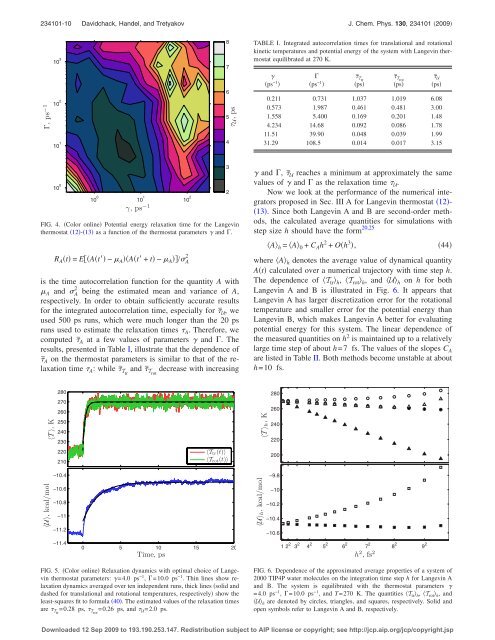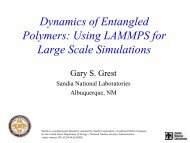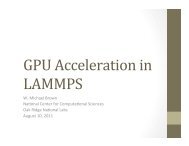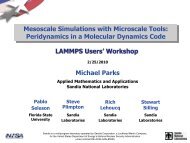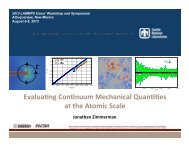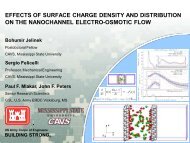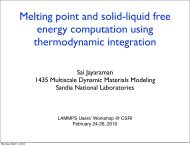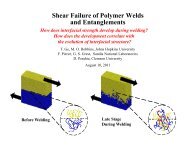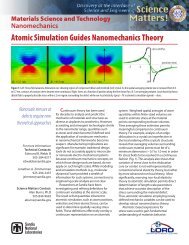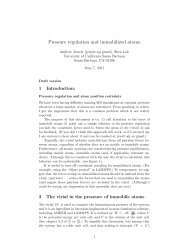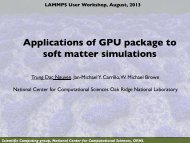Langevin thermostat for rigid body dynamics - Lammps
Langevin thermostat for rigid body dynamics - Lammps
Langevin thermostat for rigid body dynamics - Lammps
You also want an ePaper? Increase the reach of your titles
YUMPU automatically turns print PDFs into web optimized ePapers that Google loves.
234101-10 Davidchack, Handel, and Tretyakov J. Chem. Phys. 130, 234101 2009<br />
Γ, ps −1<br />
10 3 γ,ps −1<br />
10 2<br />
10 1<br />
8<br />
7<br />
6<br />
τU, ps<br />
5<br />
4<br />
TABLE I. Integrated autocorrelation times <strong>for</strong> translational and rotational<br />
kinetic temperatures and potential energy of the system with <strong>Langevin</strong> <strong>thermostat</strong><br />
equilibrated at 270 K.<br />
<br />
ps −1 <br />
<br />
ps −1 <br />
¯Ttr<br />
ps<br />
¯Trot<br />
ps<br />
¯U<br />
ps<br />
0.211 0.731 1.037 1.019 6.08<br />
0.573 1.987 0.461 0.481 3.00<br />
1.558 5.400 0.169 0.201 1.48<br />
4.234 14.68 0.092 0.086 1.78<br />
11.51 39.90 0.048 0.039 1.99<br />
31.29 108.5 0.014 0.017 3.15<br />
10 0<br />
10 0 10 1 10 2<br />
FIG. 4. Color online Potential energy relaxation time <strong>for</strong> the <strong>Langevin</strong><br />
<strong>thermostat</strong> 12-13 as a function of the <strong>thermostat</strong> parameters and .<br />
R A t = EAt − A At + t − A / A<br />
2<br />
is the time autocorrelation function <strong>for</strong> the quantity A with<br />
A and A 2 being the estimated mean and variance of A,<br />
respectively. In order to obtain sufficiently accurate results<br />
<strong>for</strong> the integrated autocorrelation time, especially <strong>for</strong> ¯U, we<br />
used 500 ps runs, which were much longer than the 20 ps<br />
runs used to estimate the relaxation times A . There<strong>for</strong>e, we<br />
computed ¯A at a few values of parameters and . The<br />
results, presented in Table I, illustrate that the dependence of<br />
¯A on the <strong>thermostat</strong> parameters is similar to that of the relaxation<br />
time A : while ¯Ttr and ¯Trot decrease with increasing<br />
3<br />
2<br />
and , ¯U reaches a minimum at approximately the same<br />
values of and as the relaxation time U .<br />
Now we look at the per<strong>for</strong>mance of the numerical integrators<br />
proposed in Sec. III A <strong>for</strong> <strong>Langevin</strong> <strong>thermostat</strong> 12-<br />
13. Since both <strong>Langevin</strong> A and B are second-order methods,<br />
the calculated average quantities <strong>for</strong> simulations with<br />
step size h should have the <strong>for</strong>m 20,25<br />
A h = A 0 + C A h 2 + Oh 3 ,<br />
44<br />
where A h denotes the average value of dynamical quantity<br />
At calculated over a numerical trajectory with time step h.<br />
The dependence of T tr h , T rot h , and U h on h <strong>for</strong> both<br />
<strong>Langevin</strong> A and B is illustrated in Fig. 6. It appears that<br />
<strong>Langevin</strong> A has larger discretization error <strong>for</strong> the rotational<br />
temperature and smaller error <strong>for</strong> the potential energy than<br />
<strong>Langevin</strong> B, which makes <strong>Langevin</strong> A better <strong>for</strong> evaluating<br />
potential energy <strong>for</strong> this system. The linear dependence of<br />
the measured quantities on h 2 is maintained up to a relatively<br />
large time step of about h=7 fs. The values of the slopes C A<br />
are listed in Table II. Both methods become unstable at about<br />
h=10 fs.<br />
T , K<br />
U, kcal/mol<br />
280<br />
270<br />
260<br />
250<br />
240<br />
230<br />
220<br />
210<br />
−10.4<br />
−10.6<br />
−10.8<br />
−11<br />
−11.2<br />
−11.4<br />
T tr (t)<br />
T rot (t)<br />
0 5 10 15 20<br />
Time, ps<br />
〈T 〉h, K<br />
〈U〉h, kcal/mol<br />
280<br />
260<br />
240<br />
220<br />
200<br />
−9.8<br />
−10<br />
−10.2<br />
−10.4<br />
−10.6<br />
12 2 3 2 4 2 5 2 6 2 7 2 8 2 9 2<br />
h 2 , fs 2<br />
FIG. 5. Color online Relaxation <strong>dynamics</strong> with optimal choice of <strong>Langevin</strong><br />
<strong>thermostat</strong> parameters: =4.0 ps −1 , =10.0 ps −1 . Thin lines show relaxation<br />
<strong>dynamics</strong> averaged over ten independent runs, thick lines solid and<br />
dashed <strong>for</strong> translational and rotational temperatures, respectively show the<br />
least-squares fit to <strong>for</strong>mula 40. The estimated values of the relaxation times<br />
are Ttr =0.28 ps, Trot =0.26 ps, and U =2.0 ps.<br />
FIG. 6. Dependence of the approximated average properties of a system of<br />
2000 TIP4P water molecules on the integration time step h <strong>for</strong> <strong>Langevin</strong> A<br />
and B. The system is equilibrated with the <strong>thermostat</strong> parameters <br />
=4.0 ps −1 , =10.0 ps −1 , and T=270 K. The quantities T tr h , T rot h , and<br />
U h are denoted by circles, triangles, and squares, respectively. Solid and<br />
open symbols refer to <strong>Langevin</strong> A and B, respectively.<br />
Downloaded 12 Sep 2009 to 193.190.253.147. Redistribution subject to AIP license or copyright; see http://jcp.aip.org/jcp/copyright.jsp


